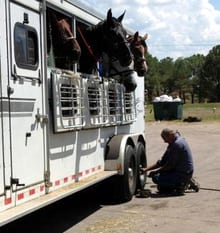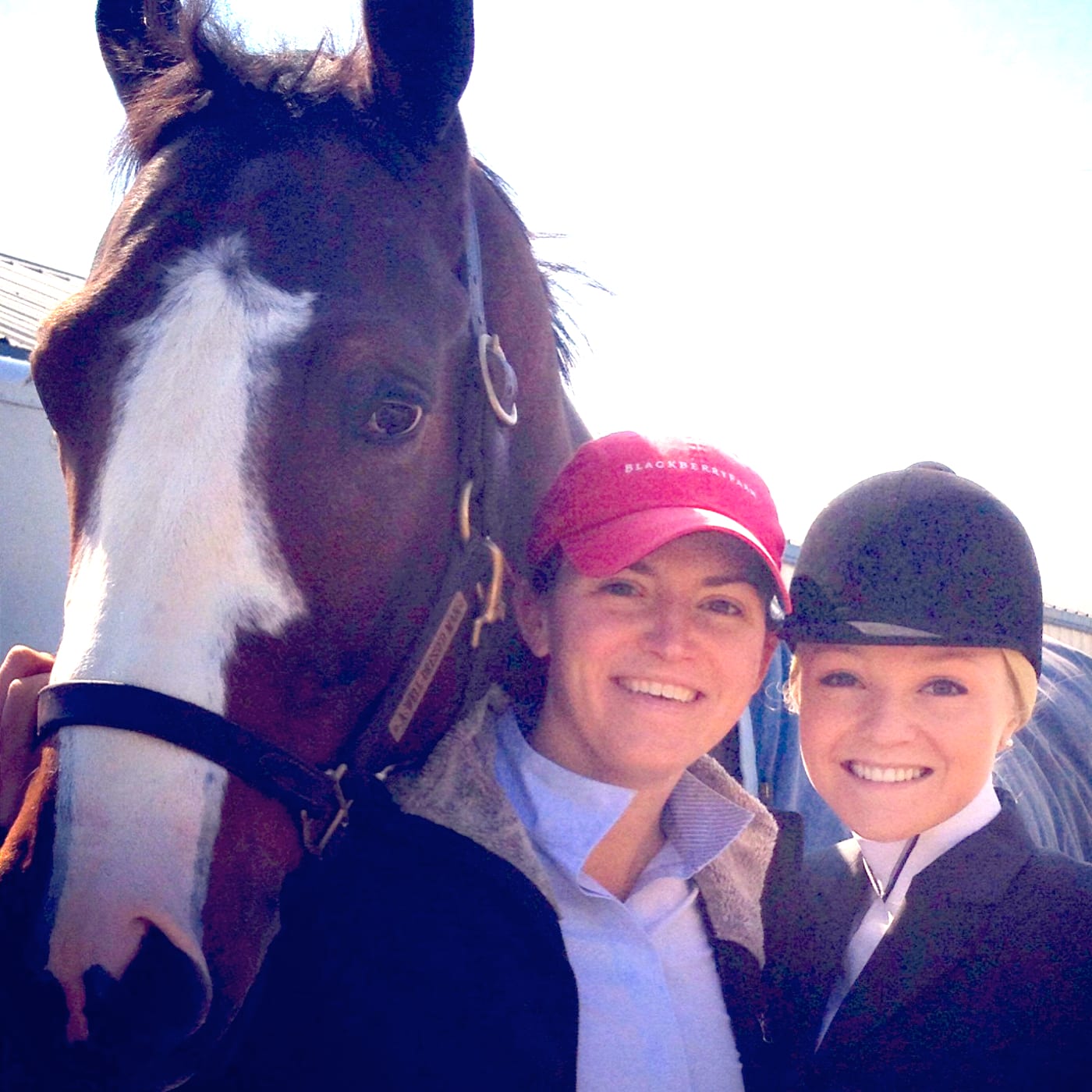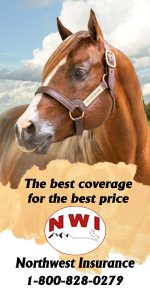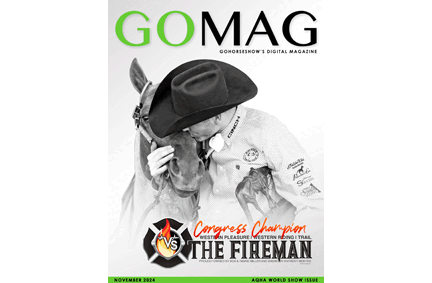GoHorseShow.com is pleased to feature the second installment of Sarah Elder Chabot’s series, Working It. An amateur exhibitor on the AQHA circuit, Chabot offers tips on how to make showing work on a limited budget. Look for her future articles for working amateurs with topics such as time management, support systems, and mental focus.
The night my husband proposed, I told him, “I want to say yes, but I cannot really bring anything monetarily to this marriage, my horse gets every penny of my paycheck.” He still asked, and I still said, “Yes.” The truth is my husband has helped me learn to manage my money a bit better and has never asked me to let go of my dreams.
Over the last ten years, I have learned some hard lessons about keeping up with my bank account and making responsible decisions when it comes to showing horses. Here’s what I know works.
SET FORTH A PLAN: Some horse shows are more expensive and some are less. I read a great article about AQHA World Champion Meghan O’Malley several years ago where she said she and her mom charted a plan to go to bigger shows with more exhibitors and found that their dollar worked more for them by getting more points in fewer shows.
Now, this certainly means you have to step it up once you get there, and you have to have the horse and the skills to make this plan work. The biggest thing to take away is to estimate out what you are willing to spend on your horse showing and plan ahead your show schedule by looking at last year’s show bills and past entry numbers. You don’t want to show up to a show with no one to compete against, but you are still paying the entry fee. And even plan for an extra show or be okay with not meeting your goals if you run out of funds.
Winning a horse show is not worth going bankrupt over, but in understanding the addiction this hobby has for me, I have certainly gotten down to $64 dollars in my bank account and understand the drive to go to just one more. Nowadays, I plan and budget for the extra show, just in case. I have found that charting my course ahead of time makes it also easier for my trainer to plan her schedule as well.
 PAD IT: Horses and life come with unexpected costs, so when you are making your budget add at least 15% to the total. You never know when you are going to need to replace a loose shoe at a horse show or buy a new pair of hunt seat pants because you spilled ice cream on them (this has never happened to me!)
PAD IT: Horses and life come with unexpected costs, so when you are making your budget add at least 15% to the total. You never know when you are going to need to replace a loose shoe at a horse show or buy a new pair of hunt seat pants because you spilled ice cream on them (this has never happened to me!)
KNOW YOUR BIGGEST COSTS and YOUR BIGGEST SKILLS: Some folks think that by buying a young or unfinished horse you can save money, but this isn’t always the case. Sometimes you end up spending more money on training then you would if you went out and bought a proven or simply further along horse.
When looking at horses you have to be honest about your skills as an exhibitor and how far you can take the horse. For example, when I bought Calvin, aka, A Well Dressed Man, I wanted a horse that would show in the following classes – Working Hunter, Equitation Over Fences, Hunter Hack, Showmanship, Hunt Seat Equitation, and Pleasure Driving. Calvin came with a start in the hunter under saddle and over fences.
For my budget, I knew I needed to spend more money on the quality of horse than experience, as I was capable of hauling him around, working through any baby issues at new facilities, advancing him over fences, etc. But I realized it would be better for me to send him to Karen Mundy for some lead change lessons. After two months, he came back with a lead change and equitation handiness. I had set a price for my horse budget before I went looking, then I made sure that the purchase price would fit into any additional training needs, vet checks and hauling.
This doesn’t work for everyone, so if you are a novice or haven’t had the experience of bringing young horses along consider an older more experienced show horse that you can spend less on training and more on maintenance or showing.  LEARN NEW TRICKS AND CUT COSTS – Beyond the show fees and stall costs, amateurs are hit with other costs associated with getting their horses in the pen like braiding or banding, trailering, training, day fees, and vet bills. So I went in search of how others save money here and there.
LEARN NEW TRICKS AND CUT COSTS – Beyond the show fees and stall costs, amateurs are hit with other costs associated with getting their horses in the pen like braiding or banding, trailering, training, day fees, and vet bills. So I went in search of how others save money here and there.
- First, find a trainer that understands your goals and your budget. There is no fun in being pressured into buying something or spending money if it is not right for you. A person that is really committed to your success will be okay with you saving money where you can. For example, in December, when I was planning my budget, I asked my trainer, Karen Evans Mundy what I needed most in regards to tack, clothing and equipment. I identified five things I knew I needed or wanted. She was great to give me a fresh perspective and helped prioritize. For example, my horse wasn’t even ready to put a show halter on, so a new showmanship jacket was at the bottom of the list. At the top, a new pair of hunt boots.
- Learn to Braid or Band – Amateur rider Kelly Mundrick braids and bands her own horses to save money on show costs. She doesn’t braid for others, but it at least saves at least $130 at each show. (Pictured above)
- Haul with a friend – I haul myself around to horse shows, and I also have a father that let’s me borrow a truck (you can look forward to article number 4 in this series on “Your Support Team”). To larger shows, I also bunk up with my friends like Lydia Whitlow Darnell in hauling and split the gas to help with the cost of longer trips.
 MAKE TOUGH DECISIONS–There is a cost to everything. It is just a matter of it coming as money, labor or time. As a competitor, you have to decide what you can give up. I used to always braid my own horses even at the big shows, now I rely on real professionals (Julie McGuffie, Patrick Lee, or Tina Freeland). I made the change, because I felt like the additional hour of sleep was worth the cost of braiding (and the pro’s lasted longer). I still maintain my skill for braiding. Recently after eight weeks on the road showing, my purse strings were getting tighter, so I decided to braid myself for half of the shows. I also used to haul my own shavings until I decided that the two dollars a bale it saved wasn’t worth the space I lost in the trailer or the energy it zapped from me.
MAKE TOUGH DECISIONS–There is a cost to everything. It is just a matter of it coming as money, labor or time. As a competitor, you have to decide what you can give up. I used to always braid my own horses even at the big shows, now I rely on real professionals (Julie McGuffie, Patrick Lee, or Tina Freeland). I made the change, because I felt like the additional hour of sleep was worth the cost of braiding (and the pro’s lasted longer). I still maintain my skill for braiding. Recently after eight weeks on the road showing, my purse strings were getting tighter, so I decided to braid myself for half of the shows. I also used to haul my own shavings until I decided that the two dollars a bale it saved wasn’t worth the space I lost in the trailer or the energy it zapped from me.
On the flip side, I drive a 2003 Explorer that I paid off years ago, giving up buying a new car so I can devote more funds to horses. My husband and I recently moved from a nice house in town to a farm house next to my parents…another set of savings that will go…well, you know where!
About Sarah Elder Chabot:
Competing on the AQHA circuit for more than 20 years, Sarah Elder Chabot has grown up showing American Quarter Horses in all classes from the hunter ring to the roping pen. With a diverse background in showing, Sarah is also a past contributor for the American Quarter Horse Journal, GoHorseShow.com and other equine publications. She currently competes on her horse, A Well Dressed Man, in amateur hunter classes, and can be seen traveling around with her favorite companion Elise, an Irish Jack Russell and her ever supportive husband, Andy. Outside of showing horses, you may see Sarah putting in a quick run, traveling to far off lands, and tasting great wine–all a part of her day job!








